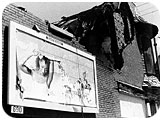| home | our mission | contact us | issue archive |

Jan 2001 / communities :: email this story to a friend

Still Life
By Christopher HarrisAfter more than two years of work, local filmmaker and collegiate instructor Christopher Harris is releasing a one-hour, non-narrative, experimental film, titled "still/here." Rightly, it's debuting at the Webster University Film Series on Thursday, January 4. It's a place where Harris teaches and a venue that's sympathetic to works that stretch boundaries and genres.
still from "still/here"
click to enlargeThat's true for Harris' black-and-white film, which meditates on the dissolution of many North St. Louis neighborhoods. Captured in striking detail by Harris and Joel Wanek, "still/here" is slow-moving at times, giving rise to a high sense of tension. (Though the introduction is a fascinating slice of quick-cut editing, shot from the top of a downtown building.) Aside from a small handful of voice-overs, the piece tells you little, citing few facts and figures, about the neighborhoods profiled. Instead, Harris and Wanek are sparing in their hints, fixing the frame and allowing your eye to interpret a sharp sense of loss in these barren blocks, as minutes tick.
Over cups of tea and coffee at Meshuggah, a coffeehouse near Harris' University City residence, Harris talked with Thomas Crone about the film, growing up on the Northside and his hopes for the film after its Webster debut. What follows are highlights from a long, wide-ranging discussion.
On the work's genesis: The film was my thesis project at the School of the Art Institute as my MFA. So that's a two year-program. I was living in Chicago and commuting to St. Louis. Joel was living in Chicago, too, as it happened. A lot of times I'd come home and shoot by myself. Other times he would come in and shoot. I probably made the trip a half-dozen times over those two years. And then I'd stop and start and run out of money. I'd shoot 1,600 feet of film and not have the money to process. All told, it took two years.
I guess the root of it was that I went away to go to school in Chicago in 1980, going to Northwestern. I ended up staying in Chicago kicking around after finishing. (Well, I didn't finish at Northwestern, but was finished with Northwestern, if you know what I mean.) I was in Chicago a good 13 years. I came here to get by BA in film at Webster in the early 1990s. Between 1980 and the early 1990s, I didn't see a lot of North St. Louis. When I did drive around, I was struck at the change. Growing up there was an occasional abandoned lot, an occasional abandoned building. But nothing on the scale that it is now. I was really struck by the amount of physical decay that part of the City had undergone when I was away. For me it was going away and coming back... like being in another dimension or something.
When I first started shooting "still/here" I knew the central image had to be an abandoned movie theater down around Jefferson and Martin Luther King, the Criterion. Joel introduced me to that before I finished at Webster. I always knew I wanted to make some kind of project with the Criterion as a central image. Over the course of that time - it was already dilapidated - the western wall had completely caved in. I just drove by there, just out of curiosity, and the ceiling is completely caved in. It's even more of a shell. It was dangerous before, but now I'd never set foot in it again. The fašade, though, hasn't greatly changed since I started.
On non-St. Louisans being the first to view the work: People had trouble believing the shape it was in. One key difference that's hard to impress on people from other places, it's nowhere near on the scale that it is here. There were entire blocks where you could go where for every house that's inhabited, there're two that are abandoned, and then a couple empty lots. Some streets with one or two houses standing, then nothing but empty lots. To the uneducated eye, it would look like a house in a field. But what it was was a house in what had been an entire street of homes with people living there. The people that live there go about their business and have to as if it were normal. It's hard for me to think about something like that... you almost have to block it out and think it's not traumatic. Or, for me, you make a film about it.
On the fieldwork and research: For the most part I was nervous, in that I didn't want to draw a lot of attention. First of all, I didn't want the police coming. There were a lot of conversations. I talked to one young lady, for half-an-hour. She was one of the few that actually asked me questions. Most asked if I was going to tear it down. They thought I was somebody from the City. A lot of times, someone may buy a home to reclaim the bricks. Or the City will target a particular home to destroy it, for safety measures. When they saw me, they thought I was a speculator for the bricks, or someone from the City. This young woman had the same concerns I did: that these were real place of absence, not just an eyesore. There was a real profound sense of loss. I consciously chose to represent these places in terms absence and loss, rather than the social change that caused them. What I was able to glean is that the reasons for this are quite complex. They have to do with direct social policy. They have to do with economics. I noticed that a lot of these buildings had been burned out. Obviously some types of arson, types of insurance scams. Landlords that have no sense of the place and the City has to take them over. A lot of it has to do with very local issues of ordinances. I don't know if that's a failure at the Aldermanic level, or not. I don't have the background to say that. The urban sprawl issue is St. Louis is really relevant. St. Louis is landlocked and can't change itself. A lot of factors that are general apply to St. Louis, and some are local as well. There are the tried-and-trued thoughts about suburbanization that are true everywhere. And some things that are unique to St. Louis.
On the end message: The way I constructed it is that there's a narrative, though it's told very loosely, throughout. As the film ends, these places don't end. In duration and in finite area. You get the sense that I could keep shooting and shooting and shooting. This film just ends.
On the film's future: I want to premiere it at Webster, then put it into the festival circuit. This would work at Webster, but not at Sundance. I think it'd be best at a small place. All over the country there are film series popping up, more and more. There's a network of programmers along the country showing experimental film. There are a whole host of venues geared towards the non-narrative.
On what comes next: I'm already in the planning stages of the next film, which will be an experimental essay on the St. Jude's Parade in Chicago. Every year, the police give a parade to honor those killed in the line of duty. I want to do a sort of visual essay on the parade and also deconstruct it in the sense that state-sponsored events like this are spectacles.
On the audience for "still/here": It's kind of a cliché and people have castigated me for saying this, but I don't have a sense of the audience when I'm making a film. Not that I have "no" sense of the audience, but I really hoped is that, yes, I hope people in the neighborhoods could see this film. But I think it's important that I get everybody I can to see this film. I feel almost as if it's a little... this is difficult for me to talk about and I don't know why... but it may have something to do with a kid that came up to me while shooting one time. He was very angry with me and he said, "Get out of here. Get out of my neighborhood. We don't want you here. I was very hurt by that, but I understand the impulse. Very often, people in these communities are represented by people outside the community who show them in ways that may not be in line, or would be sympathetic, to the way these people view themselves. It would mean a lot to me if that boy could see the film, symbolically. In a lot of ways I felt that boy was me, warring with myself.
Church and State | Games | Expatriates | Communities | From the Source
It's All Happening | Young Minds | The Ordinary Eye | Elsewhere
Sights and Sounds | Media Shoegaze | A Day's Work | From the Editor
© 2001 The Commonspace

